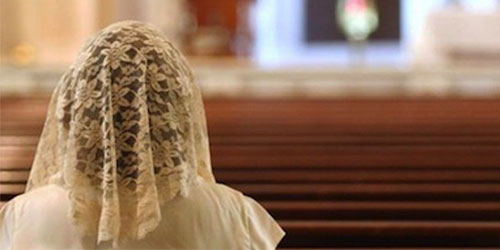
You may have seen women attending mass wearing head coverings, hijab like head scarfs, or even shawls pulled up and over their heads. This may have confused you a little, and left you wondering why they were attending a Catholic mass service. These woman are still Catholics, or to the lesser extent, one of the many Christian dominations that still follow the old tradition where women would cover their heads while praying or prophesying.
Hijabs and other head covers aren’t just something that is practiced in Islam or Judaism, up until the latter part of the 19th century, the wearing of a Mantilla was also practiced by the mainstream Christianity. Today, it is a personal choice for most western believers. Even so, it is still followed by many Orthodox Sects, Eastern European faiths, and even Anabaptist Christians – such as the Amish and Mennonites.
Contents
Head Coverings and the Christian Faith
In the bible there are several verses that can be found that support the need for women to wear a head covering while praying or prophesying. In the early days of Christianity, these verse inspired Christians to have the women cover their heads in some form or another when a tending church.
We need to be clear here that the following verses are open to interpretations. No where in the Old Testament, nor the New Testament does it explicitly state that cloth must be worn to cover women’s heads when praying or prophesying.
Hebrew Bible/Old Testament References
The Old Testament makes several references to women wearing veils and binding their hair, but does not explicitly state that they are mandatory.
Rebekah also looked up and saw Isaac. She got down from her camel and asked the servant, “Who is that man in the field coming to meet us?”
Genesis 24:64-65
“He is my master,” the servant answered. So she took her veil and covered herself.
After the priest has had the woman stand before the Lord, he shall loosen her hair and place in her hands the reminder-offering, the grain offering for jealousy,while he himself holds the bitter water that brings a curse.
Numbers 5:18
Take millstones and grind flour; take off your veil. Lift up your skirts, bare your legs, and wade through the streams.
Isaiah 47:2
New Testament Reference
In the new testament, a woman is instructed to dress modestly, and respectfully of the lord and her husband. While Paul does state that every woman who prayers or prophesies should cover their heads, he does not say with what exactly. A woman’s hair is her glory and to not cover her head amounts to her being shaved bald. So should her hair be concealed under a veil? Or bound and contained in a neat and respectful hair style?
But I want you to realize that the head of every man is Christ, and the head of the woman is man, and the head of Christ is God. Every man who prays or prophesies with his head covered dishonors his head. But every woman who prays or prophesies with her head uncovered dishonors her head—it is the same as having her head shaved. For if a woman does not cover her head, she might as well have her hair cut off; but if it is a disgrace for a woman to have her hair cut off or her head shaved, then she should cover her head.
1 Corinthians 11:3–6
Therefore I want the men everywhere to pray, lifting up holy hands without anger or disputing. I also want the women to dress modestly, with decency and propriety, adorning themselves, not with elaborate hairstyles or gold or pearls or expensive clothes, but with good deeds, appropriate for women who profess to worship God.
1 Timothy 2:8-10
Interpretations of the Verses
Some Christian dominations have taken the meaning of these verses quite literally, and require women to cover their heads as a symbol of reverence to God’s will. It is believed that wearing a mantilla signifies ones own humility, modesty and spiritual submission to God and even their husbands.
Anabaptist Christians, such as the Amish, believe that Christians are commanded to pray without ceasing, even during all manner of daily activities. As such, they believe that women should have the back of their heads covered with a Kapps at all times.
Many Eastern European Dominations such as the Russian Orthodox Church, still practice the tradition of having all female members, young and old, cover their heads with either scarfs, mantillas, handkerchiefs or shawls.
Why Did Mantillas Fall Out of Favor in Western Christianity?
The Woman’s Rights Movement of the late 19th century brought about many changes for female equality. Though this movement is not directly responsible for the change in tradition regarding mantillas, it did lead the way for women to assess every aspect of their lives, with more and more women moving away from what they viewed as oppressive traditions.
The issue many of these women had with the use of mantillas, was similar to the view many people have today with regards to hijabs and burkas, in that they believed they were oppressive, and symbolic of male dominance over women.
As cultures change and evolve, so to does the church. Today most western Catholics and Christians either chose not to wear mantillas, or are completely unaware of their existence within Christian faith.
Others make the choice for themselves, and willingly wear the mantillas as a symbol of their own devotion to the Lord and the Church. In western Catholicism and Christianity, the mantilla is now regarded as private devotion, and is no longer regarded as a symbol of women being forced to submit to their husband’s will.
A Stylish Accessory
Should you wish to reconnect with old traditions and take to wearing head coverings during mass, or public prayers, there are several styles of head covering and mantillas that you can choose from.
Here are a few such styles that can be found in different colors of lace. Should you find a style that best suits your taste, you don’t need to limit yourself to just lace. Try having a look for one that is made from a fabric or color that best suits your needs. Remember, wearing a mantilla or other head covering is your choice, and is your own personal devotion, so pick one that appeals to yourself more then anything else.
1) Chapel Veil Mantilla
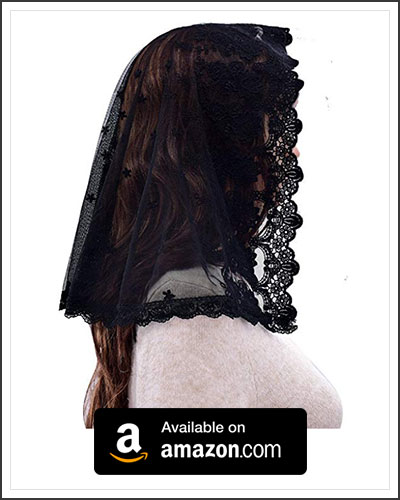
A small handkerchief like covering. These mantilla are light, and designed to be draped over the top of your head.
2) Mantilla Scarf
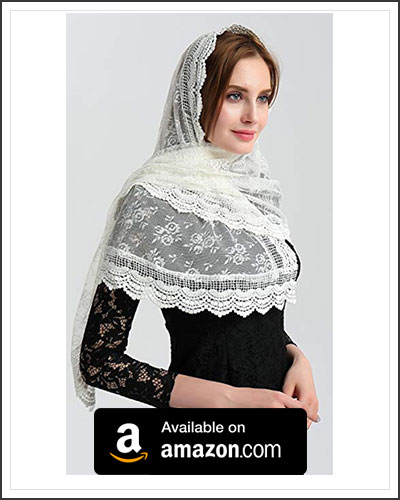
These large scarfs can be slung over your shoulders, or wrapped around your neck when not in use. Simply pull the up and over your head as you enter church or before you start your prayers.
3) Infinity Scarf Mantilla
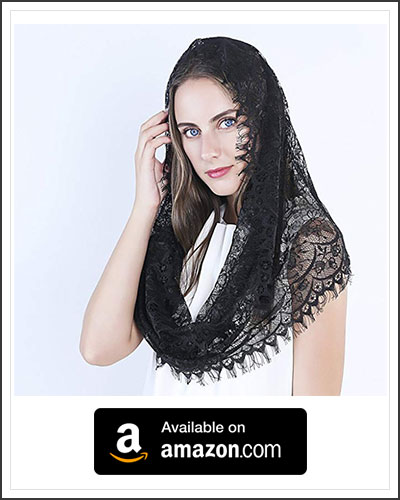
This type of scarf loops back on itself, there is no beginning or end to them. When not in use, they can be hung around your neck, and simply pulled up like a hoodie when you want to cover your head.
4) French Laced Headband

An elegant yet subtle headband that allows you to wear your mantilla without people noticing that you are wearing one. This makes it easy and convenient for you to wear your mantilla all day long, without having to worry about it being an inconvenience.
5) Chapel Cap
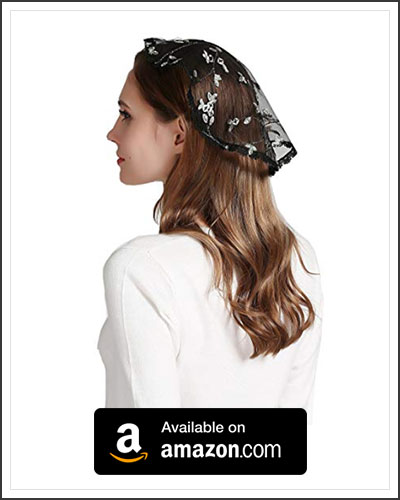
A small and delicate mantilla that is held in place with pins. Being very light and small in size allows you to easily carry this mantilla around with you.
6) Extravagant Mantilla
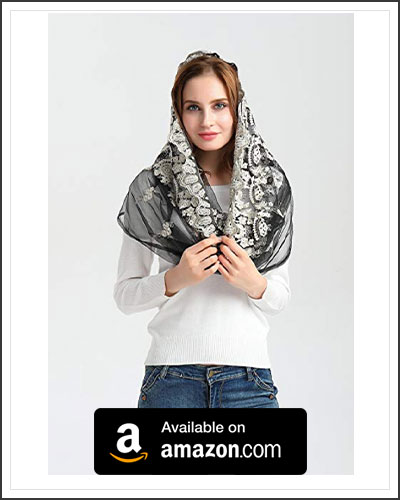
You don’t have to limit yourself to a one tone mantilla. Should you want to, you can have a mantilla that has different colors and patterns. This can make the mantilla eye catching and an excellent accessory for your ensemble.
Did you know veils are sacramentals? If you have your veil blessed by a priest, that is. If you touch your veil to a relic, it too becomes a third degree relic. I’ve started wearing a simple sheer scarf – not a frilly embroidered one- that looks more modern and matches my plain modern clothing. I wear it to show my kids that mom respects the mass, and I wear it as a small and simple act of penance for the crisis of the sins of laity and priests which currently plagues our church.
Although I respect Catherine’s reasons for veiling, I don’t share them. Aside from obeying St. Paul’s exhortation to women to cover their heads, i veil to more fully realize that Mass is a sacred period of time to adore God. When I veil I am prepared to be set apart for this worship. Also women are set apart for their exalted role of bringing immortal beings into the world. A veil is a reminder to all of this God given honor.
I wear scarves/kerchiefs, myself. You alluded to some of the Eastern Traditions. We Eastern Christians, both Orthodox and Catholic, (as far as I know) generally never wear mantillas. The type varies according to the Tradition; for example, Ethiopian women wear huge shawls made of white gauze. Eastern Slavic Tradition (mine) is typically hair pulled up (hanging down is not as modest except on young girls), with a flowered scarf that can be tied under the chin or behind the neck or around the neck, or possibly a large woolen one to cover the head and shoulders in cold weather. Look up Ukrainian or Russian scarves for pictures. This is very fortunate for me, because lace looks super-awkward on me. I’m big-boned and not at all delicate. And I can be a bit clumsy, which would make it catch on stuff, and I have sensitive skin so it would make me itch. And with all the bowing we do (a lot), and sometimes prostration, I have no idea how something drapey could stay on. So if lace or drapiness won’t work for anyone else, there are other options.
I had found a confusing, heated discussion on a webpage and sent my priest a message asking what was going on. He said read 1 Cor 11. So I read the patristic commentaries too, to get the most precise understanding. Then I asked him if they meant (for women to) cover all hair all the time, and he said yes, and then immediately, “So do you want to do this?” I hadn’t been prepared at all! I had just been wondering what people had been arguing about! I still don’t know why they were! But I myself couldn’t argue with the Bible, the Church Fathers, and my priest—figured this must be a calling—so I had to say “OK”. Covering absolutely all hair would take a hijab (which my husband hates) or an Old Believers’ veil (which I can’t find), so I try for “most”. I figured the “New” Believers—including that mostly-non-veiling parish—are still Orthodox too, so their scarves are OK.
Please note well that St. Pope Linus, the immediate Successor to St. Peter, probably mentioned in 2 Tim 4:4, promulgated as Pope that women should never enter a Church with uncovered heads. Apostolic Tradition of the Early Church during persecution, by one who is considered a Martyr due to his suffering for the Faith, despite not being actually murdered.
Pax Christi
Wondering if mandatory veiling was being applied by Paul to all women, or only married women, since unmarried women do not have a husband as their head, but Jesus.
Kimberly, my understanding is that veiling is not only for married women, because in the end, its purpose is to say that Christ is the Head of the Church… the way it would relate to married women, is that marriage is a symbol of this relationship. But it would relate to other women too, especially as they become one with Christ in the Holy Eucharist. It is like a visual statement of the Church’s submission to Our Lord. Hope that makes sense! (Veils by Lily has a great booklet about this called the Chapel Veil: Symbol of the Spouse of Christ). God bless you!